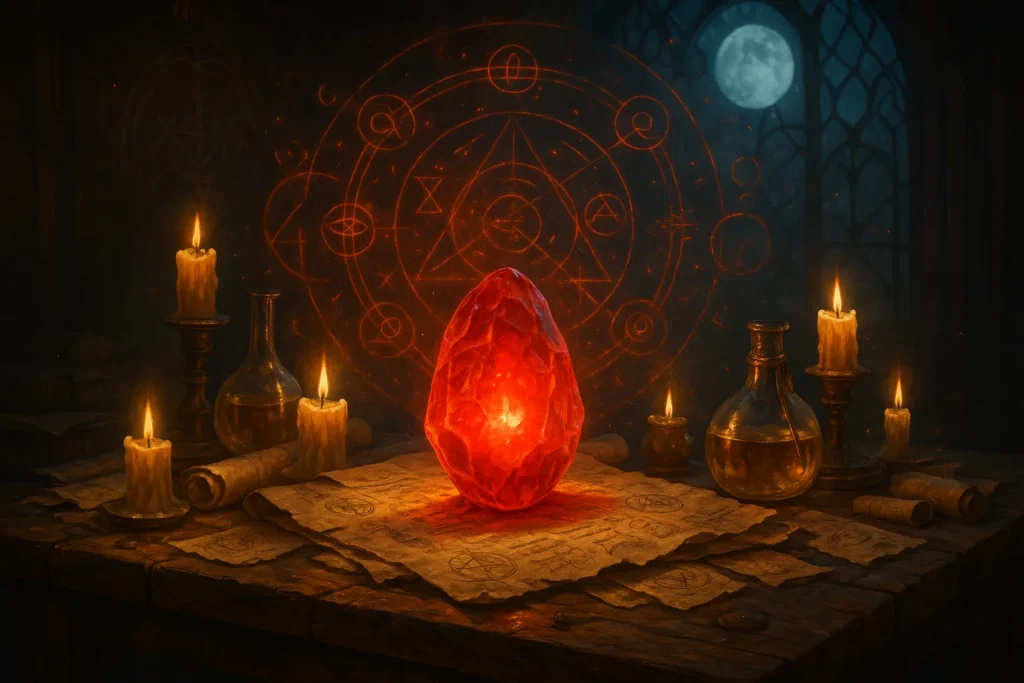Table of Contents
Imagine a Stone That Could Defy Death…
Imagine yourself sipping Butterbeer in the Gryffindor common room, the fire crackling, and someone drops a question that silences the room: “Do you think the Philosopher’s Stone was ever real?”
Now, before you say, “That’s just first-year stuff!” — think again. Because the Philosopher’s Stone isn’t just a plot device used to kickstart Harry Potter’s journey. It’s an ancient, mystical object rooted deeply in real-world alchemy and myth, with legends older than Hogwarts itself. J.K. Rowling didn’t pull it from thin air; she tapped into one of history’s most enduring fantasies: immortality.
Let’s apparate into the heart of the mystery and unearth the magical and historical truths of the Philosopher’s Stone.
The Philosopher’s Stone in the Wizarding World
Ah, the Philosopher’s Stone. The crimson elixir of the magical elite. In Harry Potter and the Philosopher’s Stone, this legendary object:
- Grants eternal life via the Elixir of Life
- Transforms any metal into pure gold
- Is guarded by giant chess sets, three-headed dogs, and one sneaky Mirror of Erised
It’s the very first magical mystery Harry, Ron, and Hermione tackle. And let’s be honest—that chessboard scene? Pure wizarding cinema gold.
But this wasn’t just another trinket locked away by Dumbledore. The Stone belonged to Nicolas Flamel, a name as real in our world as he is magical in theirs.
“To the well-organized mind, death is but the next great adventure.” — Albus Dumbledore
(Unless, of course, you have a Philosopher’s Stone. Then… why rush?)
Alchemy and the Real Philosopher’s Stone
Long before Harry Potter, alchemy was the real magic of the Middle Ages. It wasn’t just about bubbling potions or fancy sigils. Alchemists sought to:
- Transform base metals into gold
- Create the Elixir of Life
- Understand the universe through transformation
And at the heart of it all? The Philosopher’s Stone.
Real-life texts whispered about it. Ancient scrolls from Egypt, Arabia, and Europe hinted at its existence. It was thought to be the Magnum Opus, the great work that could bring humanity closer to the divine.
Enter stage left: Nicolas Flamel.
Nicolas Flamel: Alchemist or Immortal?
In Rowling’s world, Flamel is the kindly 665-year-old friend of Dumbledore who just happens to have the only Stone in existence. But in our Muggle history books, Flamel was a 14th-century French scribe with a mysterious reputation.
Rumor has it:
- He deciphered a mysterious book of alchemy
- He achieved the Stone’s creation
- He and his wife Perenelle never aged a day after that
Some say they faked their deaths. Others say they simply moved on to another plane.
Sounds familiar? Almost like a wizard living in secret…
Want to dive deeper into Rowling’s hidden truths? Discover Dumbledore’s dirty secrets.
What If the Stone Still Existed Today?
Let’s play a magical “what if.”
What if Nicolas Flamel still walks among us, sipping green smoothies and attending TED Talks under a glamor charm? What if the Stone was hidden under the Hogsmeade Shrieking Shack, or buried within the Forbidden Forest?
Maybe it’s guarded by a family of Thestrals, or only visible under the light of a Goblet-born flame…
In fact, some fan theories suggest the Elixir of Life could explain:
- Why certain wizards seem to age very slowly
- How Dumbledore lived so long with such intense magical strain
Want more theories? Explore the mind of Luna Lovegood, the quirky genius.
Immortality: Gift or Curse?
The Philosopher’s Stone promises immortality — the dream of countless dark wizards and desperate Muggles alike. But as any centaur will tell you, meddling with the fabric of time and death rarely ends well.
Stone vs. Horcrux
Compare this to Horcruxes, Voldemort’s twisted version of immortality. The Stone:
- Requires no murder
- Doesn’t splinter your soul
- Doesn’t turn you into a noseless villain
But would living forever really be a dream?
- Outliving everyone you love
- Watching Hogwarts crumble into ruins
- Surviving the end of magic itself
It’s not so glittering now, is it?
Still, compared to the chilling prison of Azkaban, sipping Elixir in a Parisian alchemy lab sounds kind of nice…
The Philosopher’s Stone in Fan Lore & Pop Culture
Thanks to Harry Potter, the Philosopher’s Stone got a pop culture glow-up.
- Fan conventions host mock “Alchemy Trials”
- Replica Stones glitter on Etsy and wizarding shops
- Some fans have even created homemade “elixirs” using pomegranate juice and dry ice (spoiler: still mortal)
And let’s not forget its cameos in:
- Fullmetal Alchemist
- The Secrets of Nicolas Flamel (book series)
- Classic tales like Goethe’s Faust
The Stone, like the Elder Wand or the Mirror of Erised, taps into a primal desire: to defy the rules that govern us all.
Want to know the other magical tools that challenge destiny? Check out the truth about the Resurrection Stone and the Invisibility Cloak.
Final Thoughts: Is the Philosopher’s Stone Still Out There?
So, could the Philosopher’s Stone be real?
Maybe not in a potion bottle at Weasleys’ Wizard Wheezes. But as an idea—a symbol of hope, transformation, and the limits we dare to break—it very much exists.
Just like magic in the wizarding world, the Stone reminds us that legends are often grounded in truth… or at least in wonder.
So next time you’re browsing the Restricted Section or daydreaming in Potions class, ask yourself:
If you found the Philosopher’s Stone, what would you do with it?
Share your magical ideas below, or send an enchanted owl (aka, comment) our way!

